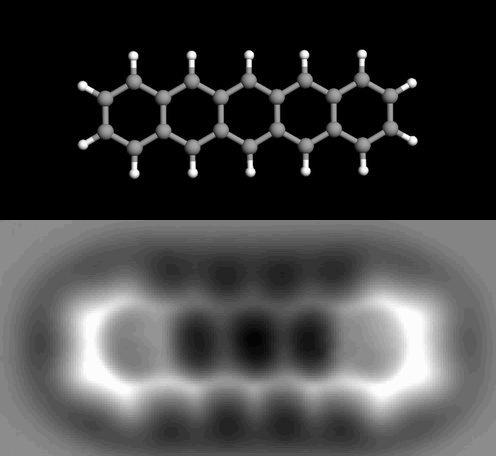IBM performed the first measurement in history of magnetic behavior at the level of individual atomic particles

At the end of the week, IBM revealed a breakthrough in the field of nanotechnology, in the form of a "data analysis pump technique", which allows a Scanning Tunneling Microscope (MMS) to help scientists "see" subatomic particles revolving around the atomic nucleus, and to understand the behavior their magnetic at the individual atom level.
The new technology, developed at IBM laboratories in Alameda, USA, may affect research and development in the field of computer memory, solar cells and quantum computing. The science and technology magazine Science dedicates the cover story in its new issue to IBM's development.
IBM's technology allows the microscope to track the changes in the magnetic field of individual atoms, each one by itself, in a similar way to how a high-speed video camera can show the movement of the wings of a hummingbird hovering in front of a single point. The new method measures processes in magnetic atoms at a speed 100,000 times higher than what was possible until now.
IBM's ongoing investment in basic science allowed scientists to measure for the first time the length of time that information can be stored on a single atom. Now, the researchers are beginning the process of studying and simulating magnetic phenomena at the atomic level - which may give rise to a new era of quantum computing, in which storage and processing operations are carried out by shifting subatomic particles to an orbit closer to or further from the atomic nucleus, as well as storage technology at the nano level.
Just as movies convert an image and record it using high-speed photography, researchers at IBM Laboratories in Elmden, New York, use a scanning tunneling microscope to record the behavior of individual atoms. The tunnel microscope, which was developed by IBM more than twenty years ago and earned a number of the company's employees Nobel Prizes in Physics, enables a deep understanding of the nature of materials and physical and chemical processes.
The possibility of measuring phenomena at the nanosecond level opens up a new world for researchers, where the dimension of time can be added to experiments examining extremely rapid changes. In order to get the proper perspective, one must understand that the ratio between one nanosecond and one full second is equal to the ratio between one second and 30 years. Within one single nanosecond, enormous amounts of physical processes take place - which could not be studied until now.
Solar energy, quantum computing and data storage
Scientists predict that IBM's new development will enable the construction of more efficient photovoltaic cells (solar cells) than those we know today, thanks to the expansion of understanding of how the sun's energy is converted into electricity. At the same time, the development is an important step on the way to building quantum computers. Quantum computing is completely different from the computers we know today: it is not limited to the binary nature of computers contemporary, and is able to perform calculation operations that are not possible within the limitations of current technology. In the field of data storage, it will be possible to understand how much information can be stored on a single atom while ensuring the reliability of this storage.
Since the changes in the magnetic spin inside the atom are too fast to be measured directly using previous technologies in the field of tunnel scanning computing, IBM researchers developed a method to record the behavior of the magnetic particles in a manner similar to that of creating a motion picture.
IBM's "data analysis pump" uses a fast electrical pulse (pulse) that is sent to the atom and initiates a change in its magnetic character, while a lower intensity electrical pulse measures the magnetic orientation of the atom at a known point in time after initiation. The time difference between the initiation of the change and the measurement defines the measurement frame. The measurement pulses are analyzed one after the other, at tiny time intervals, in order to display the magnetic movement.
In an experiment reported by IBM researchers in an article published in Science, iron atoms were placed on top of an insulating layer, an iron layer only one atom thick, supported by a copper crystal. This structure makes it possible to study and test the properties of atoms, while maintaining their magnetic properties. Iron atoms were placed with atomic precision next to non-magnetic copper atoms, in a way that allows controlling the interaction between the iron atom and the atoms close to it.
The resulting structure was measured under different magnetic fields, in a way that made it possible to discover that the speed of change in the magnetic orientation of the iron atoms depends on the magnetic field: atoms tend to "rest" and return to their original magnetic array even without undergoing a reverse magnetization process. Understanding these processes may allow scientists and engineers to plan in advance the life cycle of the individual atom in transitions between different magnet states, to extend the duration of the delay in a given state to enable information storage, or to shorten it and move to another magnetic state.
A video showing the developers of the technology explaining a little about what they did and confusing between 3 and 30:
http://www.youtube.com/watch?v=qjCOCbi6X5s

5 תגובות
Thank you, there is respect for BAM in Israel...
The scientist:
Search in the search box on this site for the concatenation of strings
"IBM Labs" Haifa
And you will get many examples
Is IBM Israel a partner in basic research of this/other kind?
I think it's great that people from all over the world dedicate the resources to make science available to the general public.
It's better that the other 12-year-olds watch this than another conspiracy theory or Lady Gaga that fills YouTube today.
YouTube? What are 12 year olds?